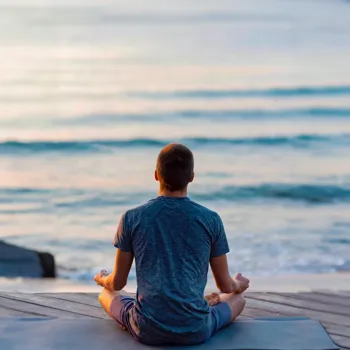Discover the transformative power of yoga and mindfulness in enhancing your daily life. Dive into 7 practices for inner peace
In the hustle-bustle of today's world, finding a moment of peace can feel like
chasing a mirage. We're constantly bombarded with notifications, deadlines, and the ever-present pressure to perform. But what if I told you there was a way to reclaim your inner calm, right in the middle of the chaos?
The answer, my friends, lies in the ancient practice of yoga, not just as a physical exercise, but as a powerful tool for cultivating mindfulness. Think of it as your personal reset button, always available to help you reconnect with yourself.
Yoga, you see, is not about twisting yourself into impossible pretzels; it's about finding stillness in movement, and using that stillness to create a calmer, more focused you.
Now, many people think yoga is all about complicated postures and chanting Sanskrit mantras.
And while those are certainly aspects of it, the heart of yoga is simply being present. It's about paying attention to your breath, noticing the sensations in your body, and accepting each moment as it comes, without judgment.
When you practice mindfulness through yoga, you're essentially training your brain to stay grounded in the present, instead of getting caught up in worries about the future or regrets about the past. It's like giving your mind a much-needed vacation, a chance to recharge and come back stronger.
The beauty of these practices lies in their accessibility. You don't need fancy equipment or a guru to guide you; you can start right now, right where you are.
Let's dive into seven simple yoga practices that can help you incorporate mindfulness into your daily life, breathing new energy into your routine and giving a boost to your overall well-being.
Mindful Breathing (Pranayama): The Foundation of Calm
Pranayama, or breath control, is the cornerstone of any yoga practice. It's like the seed from which all other benefits sprout. One of the simplest and most effective techniques is Anulom Vilom, or alternate nostril breathing. To do this, sit comfortably with your spine straight.
Close your right nostril with your thumb and inhale deeply through your left nostril. Then, close your left nostril with your ring finger, release your right nostril, and exhale slowly through your right nostril.
Inhale through your right nostril, close it, release your left nostril, and exhale through your left nostril. Continue this cycle for 5-10 minutes. This practice helps to balance the two hemispheres of the brain, reduce stress, and promote a sense of calm.
Another wonderfully simple technique is deep belly breathing. Simply place your hands on your abdomen, close your eyes, and inhale deeply, feeling your belly expand as you fill your lungs with air. Exhale slowly, contracting your abdominal muscles.
Repeat this for several minutes, focusing on the sensation of your breath. You'll be surprised at how quickly it can calm your nerves and bring you back to the present moment.
The power of mindful breathing lies in its ability to anchor you to the present moment.
When you're consciously focusing on your breath, you're less likely to get caught up in your thoughts, anxieties, or distractions. It's like having a personal anchor that keeps you grounded amidst the storms of life. Furthermore, pranayama has a profound impact on your nervous system.
It can lower your heart rate, reduce blood pressure, and promote relaxation. In our fast-paced world, where stress is often considered a badge of honor, taking a few minutes each day to engage in mindful breathing can be a revolutionary act of self-care. Remember, your breath is always with you.
It's a constant source of comfort and stability. All you have to do is pay attention to it. Start with just a few minutes each day and gradually increase the duration as you become more comfortable.
With regular practice, you'll find yourself feeling calmer, more centered, and more resilient, even in the most challenging situations. This is a game-changer for a life filled with tranquility.
Gentle Stretching (Asanas): Releasing Tension, Finding Ease
Yoga asanas, or postures, are more than just physical exercises. They are an opportunity to connect with your body, release tension, and cultivate a greater sense of awareness. You don't have to be a gymnast to enjoy the benefits of yoga postures.
Simple stretches like neck rolls, shoulder shrugs, and gentle backbends can work wonders for releasing pent-up stress and promoting flexibility. A great way to start is with a simple seated twist.
Sit comfortably with your legs crossed or extended, and gently twist your torso to the right, placing your left hand on your right knee and your right hand behind you. Hold the pose for a few breaths, then repeat on the other side.
This posture helps to improve spinal mobility and release tension in the back and shoulders. Another wonderful posture for beginners is the child's pose. Kneel on the floor with your big toes touching and your knees hip-width apart. Lower your torso between your knees, extending your arms forward.
Rest your forehead on the floor and relax. This pose is incredibly calming and grounding, and it's a great way to release stress and anxiety.
When you approach yoga asanas with mindfulness, you're not just going through the motions; you're paying attention to the sensations in your body.
You're noticing where you feel tight, where you feel open, and where you feel any discomfort. This awareness can help you to identify areas in your body where you're holding tension, and it can also help you to develop a deeper sense of connection to yourself.
Moreover, mindful movement can improve your proprioception, which is your body's awareness of its position in space. This can improve your balance, coordination, and overall sense of well-being. So, the next time you're feeling stressed or overwhelmed, take a few moments to stretch your body.
You don't have to do a full yoga routine; even a few simple stretches can make a big difference in how you feel. Remember to listen to your body and move with compassion. Avoid pushing yourself too hard, and respect your limitations.
Yoga is not about competition; it's about self-acceptance and self-care.
Body Scan Meditation: Tuning into Your Inner Landscape
Body scan meditation is a powerful technique for cultivating body awareness and reducing stress. It involves systematically scanning your body from head to toe, paying attention to the sensations in each part of your body.

To practice body scan meditation, lie down comfortably on your back with your arms at your sides and your eyes closed. Start by focusing on your breath for a few moments, allowing yourself to settle into a state of relaxation. Then, begin to focus your attention on your toes.
Notice any sensations you feel there, such as tingling, warmth, or pressure. Gradually move your attention up your body, focusing on each part of your body in turn. Pay attention to your feet, ankles, calves, knees, thighs, hips, abdomen, chest, back, shoulders, arms, hands, neck, face, and head.
As you scan your body, you may notice sensations that are pleasant, unpleasant, or neutral. Simply acknowledge these sensations without judgment and without trying to change them. Allow yourself to experience each sensation fully, and then move on to the next part of your body.
If your mind wanders, gently guide it back to the part of your body you're focusing on.
The beauty of body scan meditation lies in its simplicity and its accessibility. You can do it anywhere, anytime, and you don't need any special equipment or training.
It's a wonderful way to connect with your body and to develop a greater sense of self-awareness. Furthermore, body scan meditation can help you to identify areas in your body where you're holding tension or stress.
By bringing awareness to these areas, you can begin to release the tension and promote relaxation. This practice is also helpful for managing chronic pain. By focusing on the sensations in your body, you can learn to cope with pain more effectively and to reduce your reliance on medication.
Start with just a few minutes each day and gradually increase the duration as you become more comfortable. With regular practice, you'll find yourself feeling more grounded, more connected to your body, and more at peace with yourself.
Walking Meditation: Finding Stillness in Motion
Walking meditation is a simple yet profound practice that can help you cultivate mindfulness while moving. It involves paying attention to the sensations of your feet making contact with the ground as you walk.

To practice walking meditation, find a quiet place where you can walk undisturbed for a few minutes. Stand with your feet shoulder-width apart and your arms relaxed at your sides. Take a few deep breaths to center yourself.
Then, begin to walk slowly, paying attention to the sensations in your feet. Notice how your feet feel as they lift off the ground, as they move forward, and as they make contact with the ground again. Feel the weight of your body shift from one foot to the other.
Notice the texture of the ground beneath your feet. Pay attention to the sensations of your muscles moving and your bones supporting you. If your mind wanders, gently guide it back to the sensations in your feet.
You can also focus on your breath, noticing how it flows in and out of your body as you walk.
Walking meditation is effective because it combines the benefits of physical activity with the benefits of mindfulness. It's a wonderful way to clear your head, reduce stress, and connect with nature.
Furthermore, walking meditation can improve your balance, coordination, and overall physical health. It's also a great way to get some exercise without putting too much strain on your joints. This practice is very accessible.
You can do it anywhere, anytime, and you don't need any special equipment or training. All you need is a pair of shoes and a desire to be present in the moment. Start with just a few minutes each day and gradually increase the duration as you become more comfortable.
With regular practice, you'll find yourself feeling more grounded, more connected to your surroundings, and more at peace with yourself.
Mindful Eating: Savoring Each Bite
Mindful eating is a powerful practice that can transform your relationship with food and your overall well-being. It involves paying attention to the sensations of taste, smell, texture, and sight as you eat, without judgment or distraction.

To practice is to eliminate distractions like television, phones, or books. Sit comfortably at a table and take a moment to appreciate the food in front of you. Notice its colors, shapes, and textures. Take a deep breath and savor the aroma.
Then, take a small bite and chew it slowly and deliberately. Pay attention to the flavors and sensations in your mouth. Notice how the food feels as it moves down your throat and into your stomach. As you eat, notice your thoughts and emotions. Are you feeling happy, sad, stressed, or bored?
Acknowledge these feelings without judgment. If you notice yourself rushing through your meal or getting distracted, gently guide your attention back to the sensations of eating.
Mindful eating reduces overeating which results in better digestion.
Furthermore, mindful eating can help you to develop a greater appreciation for food and a deeper connection to your body. It's also a great way to reduce stress, improve your mood, and boost your immune system. Start with just one meal a day and gradually incorporate it into more of your meals.
With regular practice, you'll find yourself feeling more satisfied, more in control of your eating habits, and more at peace with yourself.
Gratitude Journaling: Focusing on the Positive
Gratitude journaling is a simple yet powerful practice that can shift your focus from what you lack to what you have, fostering a sense of contentment and joy. It involves regularly writing down things you are grateful for, no matter how big or small.
To practice gratitude journaling, find a notebook or journal and a pen. Each day, take a few minutes to write down three to five things you are grateful for. These can be anything from the sunshine to a good cup of tea to a loving relationship.
The key is to be specific and to focus on the positive aspects of your life. As you write, take a moment to savor each item and to feel the gratitude in your heart. Don't just list things off; really try to connect with the emotions of gratitude and appreciation.
You can also write about people you are grateful for and why you appreciate them. This is a great way to strengthen your relationships and to spread positivity to others.
Gratitude journaling can shift your perspective from negative to more positive.
Furthermore, gratitude journaling can improve your mood, reduce stress, and boost your immune system. It's also a great way to cultivate resilience and to cope with challenges more effectively. This practice requires minimal effort.
All you need is a notebook and a pen, and you can do it anywhere, anytime.
AI Generated Content. Glance/InMobi shall have no liability for the content









